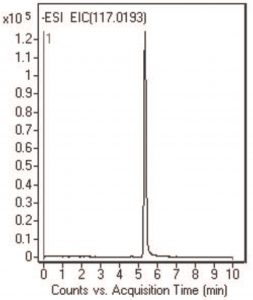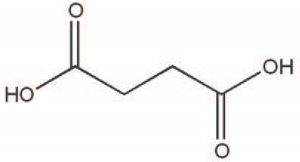Isocratic or Gradient
The analysis of Succinic Acid is mostly performed by Gas Chromatography (GC), Enzymatic Assays, Ion-Exclusion Chromatography (IEC) or by Reversed Phase HPLC. However, these techniques are time consuming and analysis time is very often longer than 1 hour.
In this Application Note, a rapid, cost effective screening Method for the detection of this important organic acid is presented. This method can be utilized to screen a large number of microbes producing Succinic Acid in a very short time (under 10 minutes). This proposed Method was found to be an attractive choice for the analysis of this compound in drug dissolution media, in which is it used as a pH adjuster.


Peak:
Succinic Acid 117.0193 m/z (M-H)- RT=5.33 minutes
Method Conditions:
Column: Cogent Diamond Hydride™, 4µm, 100Å
Catalog No.: 70000-15P-2
Dimensions: 2.1 x 150 mm
Solvents:
—A: 50% Methanol / 50% DI Water / 10mM Ammonium Acetate
—B: 90% Acetonitrile / 10% DI Water / 10mM Ammonium Acetate
Gradient:
| Time (minutes) | %B |
| 0 | 100 |
| 5 | 50 |
| 7 | 50 |
| 9 | 100 |
| 10 | 100 |
Post Time: 5 minutes
Flow Rate: 0.4mL / minute
Detection: ESI – POS – Agilent 6210 MSD TOF Mass Spectrometer
Sample Preparation: 100ng / mL prepared in 50: 50 Solvent A / Solvent B and diluted 1:10 before analysis.
Notes: When isocratic runs were used, at 95% B Succinic Acid was indefinitely retained on the Column, so linear Gradient conditions were used for analysis of this important acid. All TYPE-C Cogent Columns equilibrate very rapidly to initial conditions when Gradient analysis is used. An intermediate of Tricarboxylic Acid cycle, Succinic Acid is produced and accumulated by anaerobic microorganisms. There is large interest in the production of this organic acid because it is a key compound in producing more than 30 commercially important products.
Attachment
No 87 Succinic Acid Analyzed with LCMS pdf 0.1 Mb Download File


